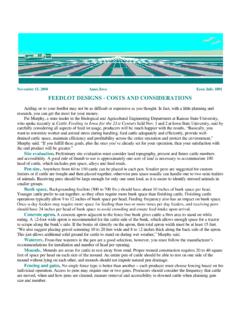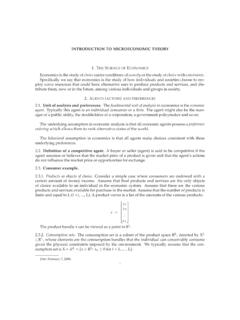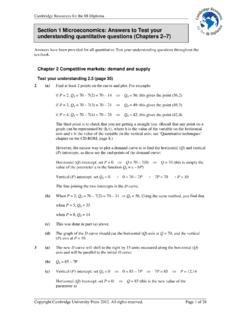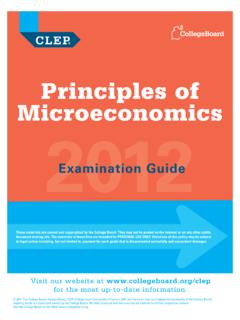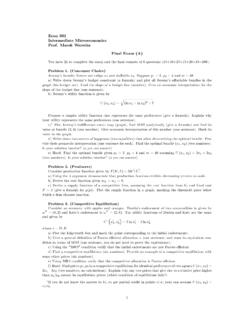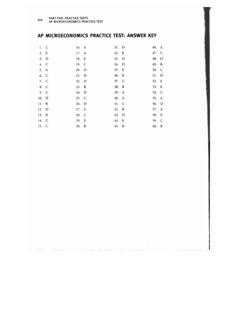Transcription of Econ 101: Principles of Microeconomics
1 econ 101 : Principles of MicroeconomicsChapter 6: ElasticityFall 2010 Herriges (ISU)Ch. 6: ElasticityFall 20101 / 26 Outline1 The Own-Price Elasticity of DemandDefinitionInterpretation2 Other Demand ElasticitiesThe Cross-Price Elasticity of DemandThe Income Elasticity of Demand3 The Price Elasticity of SupplyHerriges (ISU)Ch. 6: ElasticityFall 20102 / 26 ElasticitiesIn the past few years, the government has undertaken a number ofpolicies to stimulate the economy, including1 Direct payments to individuals;2 The Cash-for-Clunkers program to improve fuel efficiency andstimulate car sales;3 Lower interest rates to encourage housing sales; and4 Funding for massive highway and other infrastructure efficacy of these programs depends, in part, onhow muchsupplyand demand change with these measure these responses using various elasticities:- Price and Income Elasticities of Demand- Price Elasticity of SupplyHerriges (ISU)Ch. 6: ElasticityFall 20103 / 26 The Own-Price Elasticity of DemandDefinitionThe Own-Price Elasticity of DemandConsider the recent Cash-of-Clunkers programExtremely popular, it quickly exhausting the $1 billion subsequently authorized an additional $2 suggests that households were indeed responsive to a change inthe price of new question is how can we measure this price responsiveness sothat the government might have better predicted demand for theprogram in the first standard measure used by economists is the Own-Price Elasticityof Demand:Own-Price Elasticity of Demand =Percent Change in the Quantity DemandedPercent Change in the PriceWe are measuring here movementalongthe demand (ISU)Ch.
2 6: ElasticityFall 20104 / 26 The Own-Price Elasticity of DemandDefinitionCar Demand and the Cash-for-Clunkers ProgramHerriges (ISU)Ch. 6: ElasticityFall 20105 / 26 The Own-Price Elasticity of DemandDefinitionComputing the Elasticity of Demand for CarsPrice ($/car)Quantity Demanded (millions/month)$20, $15, Change in Quantity Demanded=Change in Quantity DemandedInitial Quantity Demanded 100= 100= 20% Change in Price =Change in PriceInitial Price 100=15,000-20,00020,000 100= 25 Own-Price Elasticity of Demand=% Change in Quantity Demanded% Change in the Price=20 25= (ISU)Ch. 6: ElasticityFall 20106 / 26 The Own-Price Elasticity of DemandDefinitionMore on the Own-Price Elasticity of DemandNotice that the own-price elasticity of demand will typically benegative;This is due to thelaw of demandwhich says that quantity demandedgoes down as price goes text drops the negative sign for convenience, with theunderstanding that the own price elasticity is think this is a bad habit to get into and will retain the negative signwhen discussing the (ISU)Ch.
3 6: ElasticityFall 20107 / 26 The Own-Price Elasticity of DemandDefinitionThe Midpoint MethodA problem with the elasticity formula above is that you will get a differentelasticity if you consider the change in ($/car)Quantity Demanded (millions/month)$15, $20, Change in Quantity Demanded=Change in Quantity DemandedInitial Quantity Demanded 100= 100= Change in Price =Change in PriceInitial Price 100=20,000-15,00015,000 100= Elasticity of Demand=% Change in Quantity Demanded% Change in the Price= (ISU)Ch. 6: ElasticityFall 20108 / 26 The Own-Price Elasticity of DemandDefinitionThe Midpoint Method (cont d)The Midpoint Method avoids this problem by computing thepercentage changes relative to the average value rather than relativeto the initial valueIn our car example, we would get:% Change in Quantity Demanded=Change in Quantity DemandedAverage Quantity Demanded 100= 100= Change in Price =Change in PriceAverage Price 100=20,000-15,00017,500 100= Elasticity of Demand=% Change in Quantity Demanded% Change in the Price= (ISU)Ch.
4 6: ElasticityFall 20109 / 26 The Own-Price Elasticity of DemandInterpretationInterpreting the Own-Price Elasticity of DemandElasticities are a convenient measure of the responsiveness of demandto changes in natural question to ask is: What is a large price elasticity?There are two extreme cases:1 Perfectly Inelastic Demand: The Price Elasticity of Demand = This corresponds to the case in which the quantity demandeddoes notchangewith a change in the Elastic Demand: The Price Elasticity of Demand = - This corresponds to the case in which the quantity demandedswitchesfrom 0 to with a change in the (ISU)Ch. 6: ElasticityFall 201010 / 26 The Own-Price Elasticity of DemandInterpretationThe Extremes GraphicallyHerriges (ISU)Ch. 6: ElasticityFall 201011 / 26 The Own-Price Elasticity of DemandInterpretationUnit-Elastic Demand and Total RevenuesAnother convenient reference point in terms of elasticities isUnit-Elastic Demand; This corresponds to the price elasticity ofdemand being equal to whether a price elasticity is greater or less than -1 tells ushow a price change impacts the total revenues of the Revenues = Price Quantity price increases, two things happen impacting total revenues:1 The price effect: After a price increase, each unit sold sells for a higherprice, raising quantity effect: After a price increase, fewer units are sold,reducing effect dominates, depends on the price elasticity of (ISU)Ch.
5 6: ElasticityFall 201012 / 26 The Own-Price Elasticity of DemandInterpretationTotal Revenue Changes - Inelastic DemandHerriges (ISU)Ch. 6: ElasticityFall 201013 / 26 The Own-Price Elasticity of DemandInterpretationTotal Revenue Changes - Elastic DemandHerriges (ISU)Ch. 6: ElasticityFall 201014 / 26 The Own-Price Elasticity of DemandInterpretationUnit-Elastic Demand and Total Revenues (cont d)The graphs illustrate a basic result; , the larger the price elasticity(in absolute value), the larger the quantity effect will be and the morelikely revenues are to fall with a price cases emerge:1 Unit-Elastic Demand: When the Own-Price Elasticity of Demandequals -1, the price and quantity effects just offset and total revenuesare unchanged when price Demand: When the Own-Price Elasticity is smaller than -1 (inabsolute value; , between 0 and -1), then- the quantity effect is smaller than the price so that a price increase will cause total revenues to Demand: When the Own-Price Elasticity is larger than -1 (inabsolute value; , between -1 and ), then- the quantity effect is larger than the price so that a price increase will cause total revenues to (ISU)Ch.
6 6: ElasticityFall 201015 / 26 The Own-Price Elasticity of DemandInterpretationThe Same Result MathematicallyMathematically, one can show that% in Total Revenues = % in the Price + % in Quantity Demandedso that% in Total Revenues% in the Price=% in the Price% in the Price+% in Quantity Demanded% in the Price=1 + Price Elasticity of DemandOur three cases become:- Unit Elastic Demand:% in Total Revenues% in the Price= 1 + 1 = 0- Inelastic Demand:% in Total Revenues% in the Price= 1 + (> 1)>0- Elastic Demand:% in Total Revenues% in the Price= 1 + (< 1)<0 Herriges (ISU)Ch. 6: ElasticityFall 201016 / 26 The Own-Price Elasticity of DemandInterpretationWhat Factors Determine the Price Elasticity of Demand?Four factors are key in determining the Price Elasticity of Demand1 The Availability of Close SubstitutesAll else equal, the price elasticity will be larger (more elastic) if closesubstitutes (alternative goods) are the Good is a Necessity or a LuxuryAll else equal, the price elasticity will be smaller (more inelastic) forgoods the individual views as a Share of Income Spent on the GoodAll else equal, the price elasticity will be smaller (more inelastic) forgoods that are only a small portion of their overall shift in the price of the good in this case has little impact on theirother spending else equal, the price elasticity will be smaller (more inelastic) in theshort-run, but increase (become more elastic) over time as they adjustto the price (ISU)Ch.
7 6: ElasticityFall 201017 / 26 The Own-Price Elasticity of DemandInterpretationExample ElasticitiesSpecific Brands:- Tide Detergent: Pepsi: Coke: Good Categories:- Trans-Atlantic Air Travel: Ground Beef: Cigarettes: Beer: Gasoline: Categories- Transportation: Food: Clothing: Recreation: (ISU)Ch. 6: ElasticityFall 201018 / 26 Other Demand ElasticitiesOther Demand ElasticitiesThe Own-price elasticity of demand tells us how sensitive the quantitydemanded is to changes in , we saw in Chapter 3 that demand depends on many can use elasticities to measure how sensitive the quantitydemanded is to changes in these other , we will focus on two key elasticities:1 The cross-price elasticity of demand measures how much the quantitydemanded changes when the price of other goods income elasticity of demand measures how much the quantitydemanded changes when the individual s income (ISU)Ch. 6: ElasticityFall 201019 / 26 Other Demand ElasticitiesThe Cross-Price Elasticity of DemandThe Cross-Price Elasticity of DemandFormally, the cross-price elasticity of demand of good A, given achange in the price of good B, is denoted by ABand given by: AB=Percent Change in the Quantity of A DemandedPercent Change in the Price of BThe sign of the cross-price elasticity will depend upon whether thegoods are substitutes or For substitutes, we would expect the quantity demanded to increase asthe price of the substitute good with price of butter: with the price of Coke: with the price of Pepsi: beef with the price of poultry: For compliments, we would expect the quantity demanded to decreaseas the price of the compliment with the price of food: (ISU)Ch.
8 6: ElasticityFall 201020 / 26 Other Demand ElasticitiesThe Cross-Price Elasticity of DemandGraphicallyNote that the cross-price elasticity of demand is measuring how much thedemand curve shifts given the change in the price of the other (ISU)Ch. 6: ElasticityFall 201021 / 26 Other Demand ElasticitiesThe Income Elasticity of DemandThe Income Elasticity of DemandThe income elasticity of demand is formally defined as:Income Elasticity of Demand =Percent Change in the Quantity DemandedPercent Change in IncomeFor normal goods, the income elasticity of demand will be elastic ( , income elasticity>1):- Fresh fruit: Computers: Transatlantic travel: inelastic ( , income elasticity<1)- Food: Chicken: Fresh vegetables: inferior goods, the quantity demanded decreases as incomeincreases and the income elasticity will be negative- Ground beef: Bread: Potatoes: (ISU)Ch. 6: ElasticityFall 201022 / 26 The Price Elasticity of SupplyThe Price Elasticity of SupplySo far, we have focused on the demand side of the , it is also important to understand how the supply marketresponds to changing there are a variety of supply elasticities, we will focus on theOwn-Price Elasticity of Supply:Own-Price Elasticity of Demand =Percent Change in the Quantity SuppliedPercent Change in the PriceThe only real difference here from the demand elasticity is that we arenow measuring movementalongthe supply curve, rather than alongthe demand supply will typically increase with an increase in price, theown-price elasticity of supply will be we shall see, understanding the supply elasticity is important tounderstanding the impact of government interventions in themarketplace, including the impact of tax policies and price (ISU)Ch.
9 6: ElasticityFall 201023 / 26 The Price Elasticity of SupplyThe ExtremesAs was the case with demand elasticities, there are two extreme cases:1 Perfectly inelastic supply: The own-price elasticity of supply = In this case, supply does not change with a change with This is usually driven by production constraints ( , limits in terms ofhuman and physical capital used in production).- An example here might be the production of physicians, limited by thenumber of medical elastic supply: The own-price elasticity of supply = .- In this case, supply does changes drastically (from 0 to ) with achange with This is obviously an extreme case, but reflects a situation in which:Below a certain price (sayP ) production in not profitable, failing tocover the costs of that price, the firm can now make a profit and produce a largequantity of the (ISU)Ch. 6: ElasticityFall 201024 / 26 The Price Elasticity of SupplyThe Extremes GraphicallyHerriges (ISU)Ch. 6: ElasticityFall 201025 / 26 The Price Elasticity of SupplyFactors Affecting the Own-Price Elasticity of SupplyThere are many factors influencing the own-price elasticity of key factors are:1 The Availability of Inputs- Suppliers can quickly respond to changing prices if they have a readyand flexible supply of Constraining inputs will often be capital equipment (machines) used inthe production process, but can also include trained labor The own-price elasticity of supply will usually increase as we considerlonger time This is largely because firms can work around input constraints, eitherby acquiring or building additional inputs or by altering the technologiesused in (ISU)Ch.
10 6: ElasticityFall 201026 / 26
